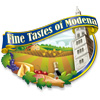Historical Notes About Traditional Balsamic Vinegar of Modena
The origins of balsamic vinegar are unknown, but there are many references to it in early history. The ancient Romans used a variety of sauces in their cuisine including defrutum, a reduction of grape must. In "Georgics" by Publio Virgilio Marone, we find references to a process of cooking grape must widely used in the Modena area. The result of this process was a condiment named defrutum, sapa or caraenum depending on the concentration. Defrutum was used to sweeten wine, but it was also widely used for the preparation of meat dishes as a single ingredient (giving a slight bittersweet taste to the food) or in combination with other seasonings.
There are also accounts of balsamic vinegar use in the Middle Ages. In the year 1046, the Benedictine Monk Donizone wrote "Vita Mathildis": a chronicle about Enrico III of Franconia traveling to Rome to be crowned Emperor of the Holy Roman Empire by Pope Clement II. Enrico III stopped in Piacenza and on that occasion, he sent a messenger to the powerful lord of Reggio Emilia, Boniface of Canossa (father of Matilda), to ask for a bit of that special vinegar produced by the Canossa family he heard so much about. Boniface was so honored by Enrico III's request, he presented him with a silver barrel containing the precious vinegar.
To find more substantial references about balsamic vinegar in history, we must go to the sixteenth century when one begins to appreciate more the bittersweet taste typical of the balsamic vinegar of Modena. Balsamic vinegar became a sophisticated and expensive product known in the courts of Europe.
At the end of the sixteenth century, the fate of Modena's balsamic vinegar is closely tied to the Estense family who at that time took possession of the Duchy of Modena. The Estense court valued so much their subjects' customs and traditions in producing balsamic vinegar that they built the 36 barrel Ducal "acetaia" in one of the towers of the palace.
It is said that Duke Francis IV of Modena always traveled with a small box of the precious liquid used to comfort his poor health. In fact the word "balsamic" was referred to its medicinal properties initially attributed to vinegar. In 1508, Lucrezia Borgia relied on its therapeutic properties during childbirth when she gave birth to her son Ercole II of Ferrara.
Balsamic vinegar was also used to combat the plague of 1630. This natural disinfectant was used for gargling or as a sterilizing agent and even a way to purify the air by placing a few drops on the coals in the fireplace.
At that time it was believed that balsamic vinegar possessed other virtues, such as being an aphrodisiac; legendarily used by Isabella Gonzaga. It seems that Casanova also appreciated its magical effect.
 Fine Tastes of Modena
Fine Tastes of Modena
follow us on: